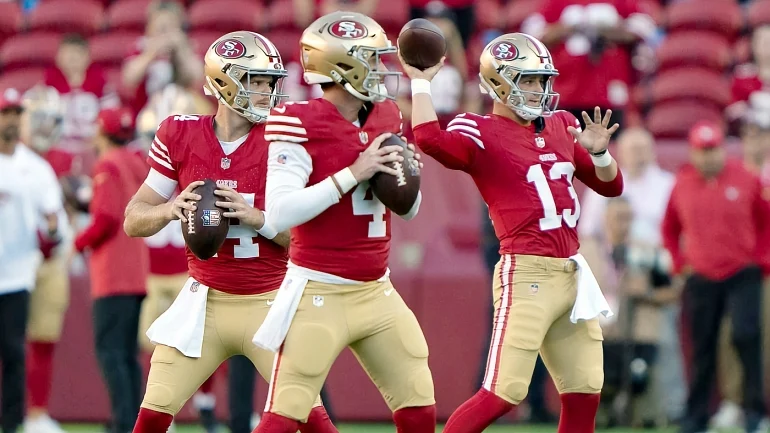The NFL wants to prevent a repeat of what happened in the NFC championship game from the previous season.
NFL owners implemented a bylaw this offseason that will become apparent in 2023. On game days, it will permit each team to start an emergency quarterback who will count against its 46-man active roster.
The league’s owners made a momentous decision with this action, clearly in response to what transpired in the 2022 NFC Championship game only the previous season. The rule considerably lowers the possibility of an incident like the San Francisco 49ers’ 31-7 loss to the Philadelphia Eagles, when quarterback injuries forced Christian McCaffrey to fill in for a sizable amount of the game at running back.
Here are the specifics of the new rule and how it might impact roster management for teams in 2023 and beyond.
What is an Emergency Third Quarterback?
Prior to a regular season or postseason game, a team must designate a genuine quarterback as their “Inactive/Emergency Third Quarterback”. The following conditions must be completed in order for such designation to be made on the Gameday Administration Report that is submitted ahead of or during the 90-minute meeting:
The Emergency Third Quarterback cannot be a member of the elevated Practise Squad and must be included on the team’s 53-player roster.
The 53-man roster of the squad must include both the starting quarterback (QB1) and the backup quarterback (QB2).
An emergency third quarterback can only be used by a team if it has two legitimate quarterbacks listed on its gameday active roster of 47 or 48 players.
If a team has three or more legitimate quarterbacks on its 47/48-player gameday active roster, it cannot designate an Emergency Third Quarterback.
The emergency quarterback can only play in a game if the active first two quarterbacks of the team are injured or disqualified. If the starting quarterback is ruled out and the backup quarterback is being examined for an injury, the emergency quarterback may join the game. If both of the first quarterbacks are declared injury-free, either one of them may rejoin the action.
Teams are not allowed to name any players whose official position is not quarterback. However, if they are on the active roster, a running back, wide receiver, or tight end could play quarterback—unless the Emergency Third Quarterback is already on the field. Third-string quarterbacks in an emergency can warm up alongside players on the active roster. The first two quarterbacks were benched, so the Emergency Third Quarterback is unable to play in a game.
The Emergency Third Quarterback is not permitted to play if a team’s first or second quarterback has an equipment issue. A team may substitute another active player or use a timeout in that particular circumstance. Trick plays like the Wildcat formation cannot be used with the Emergency Third Quarterback in the game. Only the emergency quarterback is allowed to take the snap during a game. This athlete is permitted to quick kick, but they cannot be employed on special teams as a punter or kicker. If a team violates one of these guidelines, they will be penalised for unsportsmanlike behaviour.
How Emergency Third QB must enter game
In its official Q&A list, the league describes how the Emergency Third Quarterback must enter the game.
Reporting to the referee is required of the emergency third quarterback. Only when the Emergency Third Quarterback needs to join the game or reenter it is necessary to do this after every play. If the Emergency Third Quarterback enters the game without properly reporting to the referee, there will be a penalty for unsportsmanlike behaviour. QB1 and QB2 are currently unable to play, and the referee will confirm this with the head coach, but it is not his or her obligation to judge whether the injury or medical examination is legitimate. The opposition head coach will be notified by the referee or a member of the official staff that the Emergency Third Quarterback has joined the game. The referee will also make a public announcement to that effect.
If a team designates their quarterback as one of its three players to have a radio, the Emergency Third Quarterback may have one in his helmet to hear the coaching staff. Teams often have three players with radios in their helmets: the starting quarterback, a defensive player (usually a linebacker or defensive back), and the backup quarterback. Coaches must signal plays to the Emergency Third Quarterback utilising hand signals, substitutions, or the quarterback going to the sideline if the quarterback does not have a radio in his helmet.
How Emergency Third QB must be subbed out of game for QB1 or QB2 to return
According to the NFL, this is the precise process clubs must adhere to if their QB1 or QB2 can return to the game after they have substituted in their Emergency Third Quarterback.
If the medical personnel has given either QB1 or QB2 the all-clear to resume play, the player must rejoin the game by reporting to the referee. The Emergency Third Quarterback is then required to leave the field of play and is not allowed to play quarterback or any other position going forward. If either QB1 or QB2 does not correctly report to the referee upon re-entering the game, an unsportsmanlike conduct penalty will be applied.
The opposition head coach will be informed that QB1 or QB2 has returned to the game and the Emergency Third Quarterback has left it by the referee or another member of the officiating staff. A public announcement that QB1 or QB2 has rejoined the game and the Emergency Third Quarterback has left it will be made by the referee.
The player will still be able to play if another circumstance arises that justifies their inclusion in the game, even if they are used as an Emergency Third Quarterback twice in the same game.
